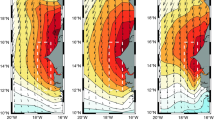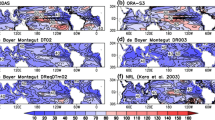Abstract
In order to understand the change in oceanic variability associated with the climate shift of the mid-1970s, we analyze the contribution of momentum forcing to the leading baroclinic modes over the tropical Pacific using Simple Ocean Data Assimilation (SODA, version 2.0.2) for the period of 1958–1997. Specifically, we look at the statistical relationship between the wind projection coefficients and climate indices and attempt to provide a physical explanation for the observed changes. It is found that the wind stress projection coefficients according to the oceanic baroclinic modes are different in terms of their magnitude and phase in the tropical Pacific, reflecting a specific forcing associated with each mode before and after the 1976 climate shift. Compared to that before the 1970s, the first baroclinic mode is had a greater effect on the interannual sea surface temperature due to equatorial wave dynamics, and there was an increased delayed response of the second baroclinic mode variability to the interannual atmospheric forcing after the late 1970s. This reflects changes in ENSO feedback processes associated with the climate shift. Our analysis further indicates that, after the late 1970s, there was a decrease in the wind stress forcing projecting onto the Ekman layer, which is associated with increased mixed-layer depth. This result suggests that the changes in the ENSO properties before and after the late 1970s are largely associated with the changes in the way in which the wind stress forcing is dynamically projected onto the surface layer of the tropical Pacific Ocean over interannual timescales.






Similar content being viewed by others
References
An SI (2004) Interdecadal changes in the El Niño–La Niña asymmetry. Geophys Res Lett 31:L23210
Blumenthal MB, Cane MA (1989) Accounting for parameter uncertainties in model verification: An illustration with tropical sea surface temperature. J Phys Oceanogr 19:815–830
Carton JA, Giese B (2008) A reanalysis of ocean climate using Simple Ocean Data Assimilation (SODA). Mon Weather Rev 136:2999–3017
Carton JA, Chepurin G, Cao X, Giese B (2000) A simple ocean data assimilation analysis of the global upper ocean 1950–95. Part I: methodology. J Phys Oceanogr 30:294–309
Conkright ME et al (2002) World ocean database 2001, vol 1. Introduction. In: Levitus S (ed) NOAA Atlas NESDIS, vol. 42. Government Printing Office, Washington, DC, 159 pp
De Boyer MC, Madec G, Fischer AS, Lazar A, Iudicone D (2004) Mixed layer depth over the global ocean: an examination of profile data and a profile-based climatology. J Geophys Res 109:C12003. doi:10.1029/2004JC002378
Dewitte B (2000) Sensitivity of an intermediate coupled ocean-atmosphere model of the tropical Pacific to its oceanic vertical structure. J Clim 13:2363–2388
Dewitte B, Reverdin G, Maes C (1999) Vertical structure of an OGCM simulation of the equatorial Pacific Ocean in 1985–1994. J Phys Oceanogr 29:1542–1570
Dewitte B, Yeh SW, Moon BK, Cibot C, Terray L (2007) Rectification of the ENSO variability by interdecadal changes in the equatorial background mean state in a CGCM simulation. J Clim 20(10):2002–2021
Dewitte B, Thual S, Yeh SW, An SI, Moon BK, Giese BS (2009) Low-Frequency variability of temperature in the vicinity of the equatorial Pacific thermocline in SODA: role of equatorial wave dynamics and ENSO asymmetry. J Clim 22:5783–5795
Eriksen CC (1988) On wind forcing and observed oceanic wave number spectra. J Geophys Res 93(C5):4985–4992
Fedorov AV, Philander SG (2001) A stability analysis of tropical ocean–atmosphere interactions: bridging measurements and theory for El Nino. J Clim 14:3086–3101
Graham NE (1994) Decadal-scale climate variability in the tropical and North Pacific during the 1970s and 1980s: observations and model results. Clim Dyn 10:135–162
Guilderson TP, Schrag DP (1998) Abrupt shift in subsurface temperatures in the tropical Pacific associated with changes in El Nino. Science 281:240–243
Hirst AC (1986) Unstable and damped equatorial modes in simple coupled ocean–atmosphere models. J Atmos Sci 43:606–630
Kirtman BP (1997) Oceanic Rossby wave dynamics and the ENSO period in a coupled model. J Clim 10:1690–1704
Lighthill MJ (1969) Dynamical response of the Indian Ocean to onset of the southwest monsoon. Phil Trans R Soc A 265:45–92
Livezey RE, Chen W (1983) Statistical field significance and its determination by Monte Carlo Techniques. Mon Weather Rev 111:46–59
Moon BK, Yeh SW, Dewitte B, Jhun JG, Kang IS, Kirtman BP (2004) Vertical structure variability in the equatorial Pacific before and after the Pacific climate shift of the 1970s. Geophys Res Lett 31:L03203. doi:10.1029/2003GL018829
Overland J, Rodionov S, Minobe S, Bond N (2008) North Pacific regime shifts: definitions, issues and recent transitions. Prog Oceanogr 77:92–102
Uppala SM et al (2005) The ERA-40 re-analysis. Q J R Meteorol Soc 131(612):2961–3012
Vecchi GA, Soden BJ, Wittenberg AT, Held IM, Leetmaa A, Harrison MJ (2006) Weakening of tropical Pacific atmospheric circulation due to anthropogenic forcing. Nature 441:73–76
Wang B, An SI (2001) Why the properties of El Nino changed during the late 1970s? Geophys Res Lett 28:3709–3712
Wang B, An SI (2002) A mechanism for decadal changes of ENSO behavior: roles of background wind changes. Clim Dyn 18:475–486
Wu R, Xie SP (2003) On equatorial Pacific surface wind changes around 1977: NCEP–NCAR reanalysis versus COADS observation. J Clim 16:167–173
Zebiak SE, Cane MA (1987) A model El Nino-Southern Oscillation. Mon. Wea. Rev., 115: 2262-2278.
Acknowledgement
This work was supported by the research fund of Hanyang University (HY-2010-N).
Author information
Authors and Affiliations
Corresponding author
Rights and permissions
About this article
Cite this article
Lee, YK., Yeh, SW., Dewitte, B. et al. The influences of interannual stratification variability and wind stress forcing on ENSO before and after the 1976 climate shift. Theor Appl Climatol 107, 623–631 (2012). https://doi.org/10.1007/s00704-011-0514-9
Received:
Accepted:
Published:
Issue Date:
DOI: https://doi.org/10.1007/s00704-011-0514-9




